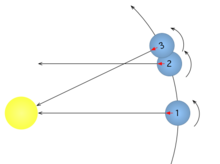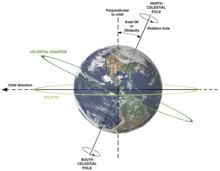EARTH ROTATION BIBLICAL
Ephesians 2:2"Wherein in time past ye walked according to the COURSE OF this WORLD, ..."
course (kôrs, k
 rs)
rs)n.
1.
a. Onward movement in a particular direction; progress: the course of events.
b. Movement in time; duration: in the course of a year.
2. The direction of continuing movement: took a northern course.
3. The route or path taken by something, such as a stream, that moves. See Synonyms at way.
Earth's rotation is the rotation of the solid Earth around its own axis. The Earth rotates towards the east. As viewed from the North Star Polaris, the Earth turns counter-clockwise.

Earth's rotation period relative to the Sun (true noon to true noon) is its true solar day or apparent solar day. It depends on the Earth's orbital motion and is thus affected by changes in the eccentricity and inclination
of Earth's orbit. Both vary over thousands of years so the annual
variation of the true solar day also varies. Generally, it is longer
than the mean solar day during two periods of the year and shorter
during another two.The true solar day tends to be longer near perihelion when the Sun apparently moves along the ecliptic through a greater angle than usual, taking about 10 seconds longer to do so. Conversely, it is about 10 seconds shorter near aphelion. It is about 20 seconds longer near a solstice when the projection of the Sun's apparent movement along the ecliptic onto the celestial equator causes the Sun to move through a greater angle than usual. Conversely, near an equinox the projection onto the equator is shorter by about 20 seconds. Currently, the perihelion and solstice effects combine to lengthen the true solar day near December 22 by 30 mean solar seconds, but the solstice effect is partially cancelled by the aphelion effect near June 19 when it is only 13 seconds longer. The effects of the equinoxes shorten it near March 26 and September 16 by 18 seconds and 21 seconds, respectively.
The average of the true solar day during the course of an entire year is the mean solar day, which contains 86,400 mean solar seconds. Currently, each of these seconds is slightly longer than an SI second because Earth's mean solar day is now slightly longer than it was during the 19th century due to tidal friction.
The average length of the mean solar day since the introduction of the
leap second in 1972 has been about 0 to 2 ms longer than 86,400 SI
seconds.Random fluctuations due to core-mantle coupling have an amplitude of about 5 ms.The mean solar second between 1750 and 1892 was chosen in 1895 by Simon Newcomb as the independent unit of time in his Tables of the Sun. These tables were used to calculate the world's ephemerides between 1900 and 1983, so this second became known as the ephemeris second. In 1967 the SI second was made equal to the ephemeris second.
The apparent solar time is a measure of the Earth's rotation and the difference between it and the mean solar time is known as the equation of time.
Earth's rotation period relative to the fixed stars, called its stellar day by the International Earth Rotation and Reference Systems Service (IERS), is 86,164.098 903 691 seconds of mean solar time (UT1) (23h 56m 4.098 903 691s, 0.997 269 663 237 16 mean solar days).Earth's rotation period relative to the precessing or moving mean vernal equinox, misnamed its sidereal day, is 86,164.090 530 832 88 seconds of mean solar time (UT1) (23h 56m 4.090 530 832 88s, 0.997 269 566 329 08 mean solar days).Thus the sidereal day is shorter than the stellar day by about 8.4 ms. In 499 CE Aryabhata, a great mathematician-astronomer from the classical age of Indian mathematics and Indian astronomy estimated the length of sidereal day as 23h 56m 4.1s.
Both the stellar day and the sidereal day are shorter than the mean solar day by about 3 minutes 56 seconds. The mean solar day in SI seconds is available from the IERS for the periods 1623–2005and 1962–2005.
Recently (1999–2010) the average annual length of the mean solar day in excess of 86,400 SI seconds has varied between 0.25 ms and 1 ms,
which must be added to both the stellar and sidereal days given in mean
solar time above to obtain their lengths in SI seconds.
The angular speed of Earth's rotation in inertial space is (7.2921150 ± 0.0000001) ×10−5 radians per SI second (mean solar second).Multiplying by (180°/π radians)×(86,400 seconds/mean solar day) yields
360.9856°/mean solar day, indicating that Earth rotates more than 360°
relative to the fixed stars in one solar day. Earth's movement along its
nearly circular orbit while it is rotating once around its axis
requires that Earth rotate slightly more than once relative to the fixed
stars before the mean Sun can pass overhead again, even though it
rotates only once (360°) relative to the mean Sun. Multiplying the value in rad/s by Earth's equatorial radius of 6,378,137 m (WGS84 ellipsoid) (factors of 2π radians needed by both cancel) yields an equatorial speed of 465.1 m/s, 1,674.4 km/h or 1,040.4 mi/h.Some sources state that Earth's equatorial speed is slightly less, or 1,669.8 km/h.This is obtained by dividing Earth's equatorial circumference by 24 hours.
However, the use of only one circumference unwittingly implies only one
rotation in inertial space, so the corresponding time unit must be a
sidereal hour. This is confirmed by multiplying by the number of
sidereal days in one mean solar day, 1.002 737 909 350 795,which yields the equatorial speed in mean solar hours given above of 1,674.4 km/h.
The permanent monitoring of the Earth's rotation requires the use of Very Long Baseline Interferometry coordinated with the Global Positioning System, Satellite laser ranging, and other satellite techniques.
This provides the absolute reference for the determination of universal time, precession, and nutation.
Over millions of years, the rotation is significantly slowed by gravitational interactions with the Moon; both rotational energy and angular momentum are being slowly transferred to the Moon: see tidal acceleration. However some large scale events, such as the 2004 Indian Ocean earthquake, have caused the rotation to speed up by around 3 microseconds by affecting the Earth's moment of inertia.Post-glacial rebound, ongoing since the last Ice age, is also changing the distribution of the Earth's mass thus affecting the moment of inertia of the Earth and, by the conservation of angular momentum, the Earth's rotation period.
Precession, nutation, and polar motion
The Earth's rotation axis moves with respect to the fixed stars (inertial space); the components of this motion are precession and nutation. The Earth's rotation axis also moves with respect to the Earth's crust; this is called polar motion.Precession is a rotation of the Earth's rotation axis, caused primarily by external torques from the gravity of the Sun, Moon and other bodies. The polar motion is primarily due to free core nutation and the Chandler wobble.
Let us walk honestly, as in the day;(Romans 13:13)
"walk" to a literal definition is "To go,or travel "the day travel when the earth rotates Atomic clocks show that a modern day is longer by about 1.7 milliseconds than a century ago,slowly increasing the rate at which UTC is adjusted by leap seconds.
How Long it Takes for Earth to Orbit the Sun
If one was asked the questions, “How long is a day?” and “How long is a year?” they would probably be very offended by such a simple question. A day is 24 hours, while a year is 365 days long, 366 during a leap year.
If one was asked the questions, “How long is a day?” and “How long is a year?” they would probably be very offended by such a simple question. A day is 24 hours, while a year is 365 days long, 366 during a leap year.
The Earth rotates once in about 24 hours with respect to the sun and once every 23 hours 56 minutes and 4 seconds with respect to the stars (see below). Earth's rotation is slowing slightly with time; thus, a day was shorter in the past. This is due to the tidal effects the Moon has on Earth's rotation. Atomic clocks show that a modern day is longer by about 1.7 milliseconds than a century ago,slowly increasing the rate at which UTC is adjusted by leap seconds.
Main article: Solar time
Earth's rotation period relative to the Sun (true noon to true noon) is its true solar day or apparent solar day. It depends on the Earth's orbital motion and is thus affected by changes in the eccentricity and inclination of Earth's orbit. Both vary over thousands of years so the annual variation of the true solar day also varies. Generally, it is longer than the mean solar day during two periods of the year and shorter during another two. The true solar day tends to be longer near perihelion when the Sun apparently moves along the ecliptic through a greater angle than usual, taking about 10 seconds longer to do so. Conversely, it is about 10 seconds shorter near aphelion. It is about 20 seconds longer near a solstice when the projection of the Sun's apparent movement along the ecliptic onto the celestial equator causes the Sun to move through a greater angle than usual. Conversely, near anequinox the projection onto the equator is shorter by about 20 seconds. Currently, the perihelion and solstice effects combine to lengthen the true solar day near December 22 by 30 mean solar seconds, but the solstice effect is partially cancelled by the aphelion effect near June 19 when it is only13 seconds longer. The effects of the equinoxes shorten it near March 26 and September 16 by 18 seconds and 21 seconds, respectively.
A Hebrew Hour is defined as 1/12 of the time between sunset and sunrise, or 1/12 of the time between sunrise and sunset. The only Scriptural reference to there being 12 Hebrew Hours in a Hebrew Day is found inJohn 11:9 where יהושע the Messiah asked a famous question, "Are there not 12 hours in a day?"
The average of the true solar day during the course of an entire year is the mean solar day, which contains 86,400 mean solar seconds. Currently, each of these seconds is slightly longer than anSI second because Earth's mean solar day is now slightly longer than it was during the 19th century due to tidal friction. The average length of the mean solar day since the introduction of the leap second in 1972 has been about 0 to 2 ms longer than 86,400 SI seconds.Random fluctuations due to core-mantle coupling have an amplitude of about 5 ms. The mean solar second between 1750 and 1892 was chosen in 1895 by Simon Newcomb as the independent unit of time in his Tables of the Sun. These tables were used to calculate the world's ephemeridesbetween 1900 and 1983, so this second became known as the ephemeris second. In 1967 the SI second was made equal to the ephemeris second.
The apparent solar time is a measure of the Earth's rotation and the difference between it and the mean solar time is known as the equation of time.






Comments
Post a Comment